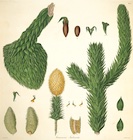
Illustration of Araucaria imbricata (A. araucana) from the 1837 edition of Lambert's A Description of the Genus Pinus.
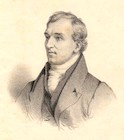
David Douglas, ca. 1834 [Curtis's Botanical Magazine via Wikipedia].
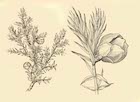
Juniperus drupacea [Loudon 1844].
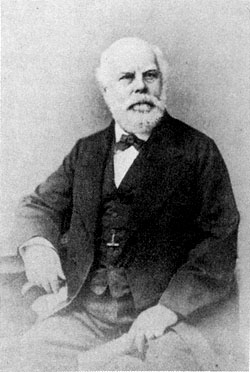
George Engelmann in 1880 [Missouri Botanical Garden via Wikipedia].

Illustration from the first edition of Engler and Prantl.
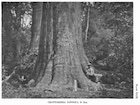
A remarkably large Cryptomeria japonica, photographed by E. H. Wilson in Japan [The Conifers and Taxads of Japan, 1916].
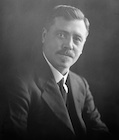
"Chinese" Wilson, ca. 1919-1930 [Arnold Arboretum via Boston Library].

Drawing of Tsuga sieboldii by Aljos Farjon, ca. 1989 [Aljos Farjon].
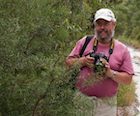
Aljos Farjon getting to know a Podocarpus in Queensland, 2009 [G. Garruthers at RBGE].
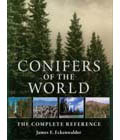
Eckenwalder, Conifers of the World
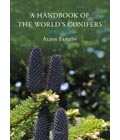
Farjon, A Handbook of the World's Conifers
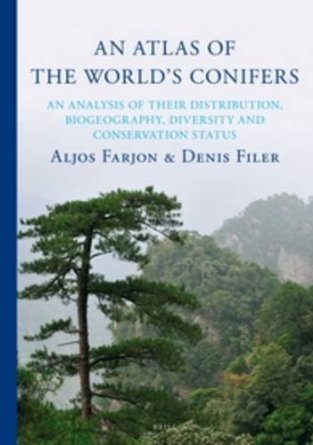
Farjon and Filer, An Atlas of the World's Conifers
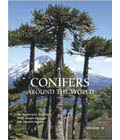
Debreczy and Racz, Conifers Around the World

A sample page spread from Conifers Around the World.

Great Conifer Botanists
A fairly small band of people have done much to shape the history of conifer botany, primarily by discovering the plants, naming and classifying them, or addressing them at an encyclopedic scope. This page discusses that history and describes or links descriptions of the responsible people.
The process begins with the work of the collectors, who find these plants in the wild and either describe them, thereby discovering them to the science of botany, or who convey them to others who then describe them. Until the development of modern medicine, mostly post-1950, the work of the collector was often dangerous; John Jeffrey disappeared without a trace into the California desert, David Douglas was killed by a wild bull, and Christian Smith died of a fever in the Congo during an ill-fated trip that became the inspiration for Joseph Conrad's novella Heart of Darkness. The collectors who survived, and some who didn't, were sometimes rather glamorous characters in the "Indiana Jones" tradition, using weapons and wits to survive depredations by cannibals, tigers, warlords, etc. E.H. Wilson was a good example of the type. Many others, though, were gentleman botanists, despatched by the English, French, or Germans (in most cases) to serve in remote colonies where they discharged various professional responsibilities, and passed their available spare time in botanical exploration. These men (for they were nearly all men) were generally scientists as well, but are most often known and remembered for their fieldwork.
The second group, those who have named and classified the plants, were initially stay-at-home types who mostly described and classified the specimens sent back by the collectors. A good example was William Jackson Hooker, who founded the botanic garden at Kew and, though he made no more daring explorations than a trip to Iceland, was extremely important in directing collectors' trips abroad and in describing and learning from their collections. Many others, though, beginning with Hooker's son Joseph, undertook field collections in exotic locales, and also described, analyzed, and published the results of their work. This tradition continues to this day, with the prominent new conifer discoveries of the late 20th and early 21st centuries almost all having been made by noted botanists. The most conspicuous example of this was Kew's conifer specialist, Aljos Farjon, who collected all over the world while finding time to write 11 books on the conifers, as well as to launch modern efforts to identify and protect threatened conifer species at a global scale. The noted Hungarian botanists Zsolt Debreczy and István Rácz are another example.
Note that through the history of botany, a "conifer botanist" has generally not been someone who devoted themselves to the study of conifers. Many of the most significant contributions to the conifer world have come from botanists in the broad sense, for whom conifers were often a minor feature of their work. Collectors sent to distant lands would often collect every new plant they saw, though usually with some emphasis on the horticulturally desirable species. For instance, we know that David Douglas found and described about 10 species of extremely widespread and well-known conifers, but at the same time he was introducing to cultivation literally hundreds of other species. Until well into the 20th century, botanists would never focus their work exclusively on conifers. However, beginning in the late 18th century and continuing to the present, there has been a constant demand for horticultural conifers, with the prospect of making a decent living by culturing them, developing new cultivars, and marketing the plants. Thus, the earliest conifer specialists were probably these people, along with the conifer fanciers who created the market. The appearance of such people in significant numbers was signaled by the publication of books serving the market, such as Lambert's 1803 monograph on pines and their cultivation, and trade journals, such as the Gardeners' Chronicle (published 1841-1985), as well as the formation of societies such as the Horticultural Society of London (founded 1804, now called the Royal Horticultural Society). The conifer market grew steadily, so that by the 1830s plant collectors were regularly dispatched from western Europe to such remote areas as western North America, South America, India, the Himalaya, and the Far East, finding a ready market for the seeds and plants they sent home - conifers included.
It wasn't until about 1920 that people other than horticulturalists started to focus their work exclusively on the botany of conifers. The first of them were often associated with scientific forestry, using their skills to identify optimum timber species and ways to grow them; this continues to be an active area of research. One example of such a researcher was James G. Eddy, active ca. 1918 to 1964, a successful lumberman who transitioned into the role of scientist and founded what is now the Institute of Forest Genetics in California. Another, more "pure" scientist, devoted to the close study of morphology and phylogenetic relations within groups of conifers, was J. T. Buchholz (discussed below), who completed his dissertation in the embryology of Pinus in 1917 and passed the remainder of his career (until 1951) in pure scientific research, mostly as a university professor. Buchholz was also notable for having two female graduate students who went on to become some of the earliest women working primarily in conifer botany: Podocarpaceae specialist Netta Gray (discussed below), active 1941-1970, and wood anatomist Margaret Kaeiser, active 1947-1973. Another example of such a researcher is Nicholas T. Mirov, active ca. 1930 to 1980, who focused his work largely on the study of pines, first in forestry applications but later becoming the world authority on pine chemotaxonomy. Since the mid-20th century, specialization has become obligatory in academic botany, and there are now numerous botanists spending most of their careers doing research focused on the conifers.
Here is a chronological list of the best-known collectors and taxonomists of conifers:
Philip Miller
1691-1771 |
As a botanist, Philip Miller was most active in horticulture, and did much to promote the general acceptance of a phylogenetic system of classification through his very successful work, The Gardener's Dictionary, which went through eight editions during his lifetime. He described 10 conifer taxa, of which the most notable are probably the genera Abies and Larix.
See: Wikipedia article. |
Carl Linnaeus
1707-1778 |
Linnaeus is often called the "Father of Taxonomy" because his 1735 publication of Systema Naturae was the first comprehensive attempt to place all plants and animals into a phylogenetic system of classification, with each organism given a brief binomial name. This work was extended in 1753 with his publication of Species Plantarum, devoted to the taxonomic classification of all known plants. It was a remarkably successful effort, at least as far as the conifers were concerned; he remains the cited author for 22 conifer taxa, more than any other botanist active before the 21st century.
See: Wikipedia article. |
David Douglas
1799-1834 |
There is something about David Douglas that captures the imagination; at least five book-length biographies have been written about him (the newest and best is Nisbet's The Collector). Maybe it's because he was a low-born boy who came to prominence as a fellow of the Royal Society; maybe it's because he introduced to Europe many of the best-known and most prominent plants of western North America; or maybe it's because his adventures ended in an early death on the big island of Hawaii. It's said that more plants are named for Douglas than for any other botanist (well over 200 species), though none are conifers (besides Douglas-fir, the common name for Pseudotsuga menziesii). He described only seven conifer species, but they include some of the most notable and widespread species of western North America.
See: Bio at the Lewis and Clark website, Hooker (1836), and Wikipedia article. |
David Don
1799-1841 |
David Don was a stay-at-home botanist who described 14 conifer species that had been collected by others, including taxa now in the Araucariaceae, Cupressaceae, Pinaceae and Podocarpaceae. He was a multifaceted botanist, as seen in the wide variety in this list of his publications.
See: Obituary, Wikipedia article. |
Joseph Gerhard Zuccarini
1797-1848 |
Joseph Zuccarini, German professor of botany, was another non-travelling botanist. He is remembered mainly for his work with Japanese specimens collected by Philip Franz von Siebold, which they documented in the Florae Japonicae. He is the author for 15 conifer taxa, 12 of which were coauthored with von Siebold.
See: Wikipedia article. |
John Lindley
1799-1865 |
John Lindley was a "horticultural" botanist who rose to prominence through his work with the Royal Horticultural Society, but later became Professor of Botany at University College, London. He was not a field botanist and, in fact, seldom left the vicinity of London. However, throughout his career, he was a fantastically imaginative and energetic scientist who succeeded as an artist, author, and administrator, winning many accolades. He described 11 conifer taxa in the Araucariaceae, Cupressaceae, Pinaceae and Podocarpaceae and is remembered in many plant names, though none of them are currently accepted conifer taxa.
See: Wikipedia article, Oliver (1913). |
Philipp Franz von Siebold
1796-1866 |
As noted above, von Siebold performed the Japanese collections that Zuccarini was to catalog and describe. While finding 12 Japanese conifers, he spent the years 1823-1829 in Japan; founded the first Western-tradition medical school in Japan; had a variety of adventures; and energetically collected a wide variety of plants, animals, and ethnographic materials, most of which were sent on to Europe. He spent much of his later life in writings and collaborations related to this large trove of Japanese material. He is remembered in the Japanese hemlock, Tsuga sieboldii.
See: Wikipedia article. |
George Engelmann
1809-1884 |
George Engelmann described many species and varieties of conifers in the American west. Born in Germany, he earned a medical degree. In 1832 he emigrated to the United States, establishing a medical practice in St. Louis that flourished. In his later years he was devoted to botany, mostly from the comfort of his St. Louis home, but he also made some field excursions. He is the author for 10 conifer species and is remembered in the epithets of Picea engelmannii and Pinus engelmannii.
See: Topics page and Wikipedia article. |
Élie-Abel Carrière
1818-1896 |
Carrière was another stay-at-home botanist for whom conifers were a sideline to his major works in horticulture. Nonetheless, he described some 18 accepted conifer taxa, including Keteleeria, Pseudotsuga and Tsuga. He was the author of the first really in-depth treatment of the conifers: the Traité Général des Conifères (1855, with an extensively revised second edition in 1867).
See: Wikipedia article, Williams (2004). |
Maxwell T. Masters
1833-1907 |
Masters was another botanist who did not travel and collect, but who prolifically described and advocated for botany, primarily to horticultural ends. For over 40 years (1866 to 1907, as successor to John Lindley) he edited the Gardeners' Chronicle, and he was an effective activist for British botanical interests, protecting Kew, Chiswick Gardens, and the Lindley Library from abuse or ruin. Along the way he described some 21 recognized conifer taxa, mostly from Asian collections, and is remembered today in the Asian taxa Larix mastersiana and Pinus armandii var. mastersiana.
See: Wikipedia article and a 1907 obituary. |
Joseph Dalton Hooker
1817-1911 |
The son of W.J. Hooker, founder of the Kew herbarium, J.D. Hooker took part in botanizing expeditions to the Antarctic, the Himalaya, India, Palestine, Morocco, and western North America. Publishing prolifically from this work, he became one of Britain's most prominent botanists. He was an enthusiastic exponent of evolution theory, described at one time as "Charles Darwin's greatest friend and confidant." He became director of the botanic gardens at Kew in 1865, by that time arguably the most prominent botanical institution on Earth (it has remained so), and held the post for 20 years. He described 14 conifer species and is remembered in the epithet of Pherosphaera hookeriana.
See: Wikipedia article, Kew biography, and Oliver (1913). |
Ernest Henry Wilson
1876-1930 |
The American collector "Chinese" Wilson was a famously daring east Asian plant-hunter in the "Indiana Jones" tradition; he wrote a number of engaging books about his adventures, such as A Naturalist in Western China. Rehder (1930) remembers, "he was a born plant collector; endowed with a strong physique, robust health, indomitable will power and a deep love of plants he succeeded in collecting and introducing into cultivation a greater number of plants than any other collector." He described 5 conifer taxa and is remembered in the Chinese spruce Picea wilsonii.
See: Wikipedia article. |
John T. Buchholz
1888-1951 |
Today he is remembered mainly for his description of Sequoiadendron, happily ending decades of "Sequoia vs. Wellingtonia" wars (see Sequoiadendron for details). John T. Buchholz did far more than that, though, with publications spanning the period from 1917 (his dissertation on pine embryology) to 1951 and examining the embryology, morphology, and field biology of several conifer groups, with emphasis in the Sequoias, the Podocarps, and the taxa native to New Caledonia. He spent most of his career (1929-1951) as a professor at the University of Illinois. He described 15 conifer taxa in the Araucariaceae, Cupressaceae, and Podocarpaceae, the latter mostly in cooperation with his most noted student, Netta Gray.
See: Wikipedia article and Schmid (2012). |
Robert Knud Friedrich Pilger
1876-1953 |
Pilger was a strict botanist, but although he did much research into the gymnosperms, he was also an authority on a variety of angiosperm families. He is mostly remembered for his 1903 analysis of the Taxaceae, where he described more taxa than are now recognized - but still, he described 11 recognized taxa. He collected plants in the Mato Grosso of Brazil, from 1945 to 1950 was director of the botanical garden at Berlin-Dahlem, and wrote most of the Gymnosperm sections for the second edition of Engler and Prantl's monumental Die natürlichen Pflanzenfamilien (unfortunately, not online). Podocarpus pilgeri is named in his honor.
See: Wikipedia article. |
Maximino Martínez
1888-1964 |
Martínez is the most historically significant Mexican botanist where conifers are concerned, though conifers were a focus for only part of his career. He wrote the first monographic treatment on the Pinaceae of Mexico, Las Pináceas Mexicanas (3 editions 1942-1963), and described a great many conifer taxa, 12 of which are still recognized as valid. Active from 1914 to 1958, he conducted extensive field collections, published prolifically, founded the herbarium at the National Polytechnic Institute, and taught at various universities throughout that period. He was a co-founder and officer of the Botanical Society of Mexico in 1941 and remained so until his death. Picea martinezii, Pinus maximartinezii, and Pinus maximinoi are named in his honor.
See: Wikipedia article, JSTOR biography, Rzedowski (1969, 1981). |
Netta Elizabeth Gray
1913-1970 |
Netta Gray did much of the early work on Podocarpus and its segregates (Afrocarpus, Nageia, Prumnopitys, and Retrophyllum). She was honored by D. J. de Laubenfels with Podocarpus grayae de Laub. The September 1973 Plant Science Bulletin carried this brief biography of Mrs. Gray: "Netta E. Gray worked and studied with John T. Buchholz at the University of Illinois. The work she started with Buchholz and later carried on herself was a careful systematic treatment of each of the sections of Podocarpus. She was concerned with the systematic importance of anatomical details, and the geographical distribution and evolution of the genus. She became one of the world's authorities on this genus [see her list of publications in Podocarpaceae] and had such visitors as R. Florin come to her door. She lived with her husband Professor Stephen W. Gray near Atlanta, Georgia and taught at Agnes Scott College in Decatur, Georgia. She continued an active interest in research and publication about the genus Podocarpus, as well as the Gymnosperms as a whole, until her death on August 24, 1970."
See: Wikipedia article. |
David J. de Laubenfels
1926-2016 |
David de Laubenfels described 81 species of conifers, over thrice as many as anyone else, all of them tropical species in the Araucariaceae and Podocarpaceae. Although his fieldwork was extensive, he is most often remembered for his 1959 work in New Caledonia when he established that Parasitaxus was in fact a parasitic conifer (the only one known). For decades he was the world authority on conifers of the southern hemisphere, and his landmark 1972 volume on the gymnosperms of New Caledonia was not surpassed until the 21st century, by which time he had also become a world authority on the taxonomy of Cycas. Today, he is remembered in the epithets of Araucaria laubenfelsii and Podocarpus laubenfelsii.
See: his personal website and his Syracuse University obituary. |
Christopher Page
b. 1942 |
Chris Page describes his works as follows: "Having travelled extensively through the 1960s, studying both pteridophytes and gymnosperms, I came to the view that so many genera of conifers were of conservation concern, and therefore made collections of their seed. By 1970 I put an ex-situ conifer conservation strategy proposal to the Royal Botanic Garden Edinburgh (RBGE), and founded the Conifer Conservation Programme (now the International Conifer Conservation Programme (ICCP)) and the IUCN Conifer Specialist Group in 1986." Chris retired from the RBGE in 1996 but remains active in conifer research, and in fact has named more species than any other living botanist - 23 at last count, due in large part to having described the genera Afrocarpus, Pectinopitys, Retrophyllum, and Sundacarpus.
See: Short bio at RBGE. |
Aljos Farjon
b. 1946 |
Aljos Farjon introduced himself to the conifers while still a young man in the Dutch Dendrological Society, gaining familiarity with the local Pinetum Blijdenstein and in 1981 producing a book of pen-and-ink illustrations of all species of Pinus. He completed his training at the University of Utrecht and the University of Oxford. Appointment as an honorary research associate at Kew soon followed, which allowed him to literally travel the world on conifer collecting trips; possibly no one else has seen as large a fraction of the world's conifers in habitat. Out of this work he has published 11 books and numerous journal articles on conifers. In work with Chris Page, Aljos also launched the program of conifer conservation planning under the auspices of the IUCN Conifer Specialist Group, which has since grown to be the foremost global agency working on conservation of the world's threatened and endangered conifer species.
See: Wikipedia article which really needs improvement (most of this info I got from Aljos himself). |
Finally, there are those botanists (some of them already mentioned) who have treated conifers at encyclopedic scope. In this capacity, these people have provided the principal avenue by which the rest of the world, when it cares, has access to the conifer knowledge base. Since 1753, when Carolus Linnaeus first cataloged conifer systematics in his Species Plantarum, such an archivist has appeared every two or three decades, and sometimes there are several of them active. Here is a chronology of the great encyclopedic works describing conifers:
- Carl Linnaeus: The first (1753) through third (1764) editions of Species Plantarum. Although containing only a bit over 20 conifers, this was the first attempt at a systematic presentation using a phylogenetic classification system.
- Philip Miller: The Gardener's Dictionary, in eight editions from 1754 to 1768. This was basically a plant encyclopedia for horticultural use. Since at that time the primary purpose of plant collection was to bring interesting plants home to Europe, horticulture effectively embraced all known vascular plant taxa.
- A. B. Lambert: A Description of the Genus Pinus, in five editions from 1803 to 1832; see also Little (1949). Despite the title, the contents included most of the known conifers.
- John C. Loudon: Hortus britannicus. A catalogue of all the plants indigenous, cultivated in, or introduced to Britain, published 1830 to 1844 (during which time the conifer treatment expanded from one page to 440 pages). It was effectively a comprehensive treatment because, at this time, nearly every known conifer had at least been attempted cultivation in Britain.
- E.-A. Carrière: Traité Général des Coniféres, two editions, one in 1855 and another in 1867. This was the first example of what we would today call a comprehensive treatment of the conifers, including all known taxa in a phylogenetic presentation that was not intended primarily for horticultural use. It was the standard reference for the remainder of the 19th century.
- Engler and Prantl: Die Natürlichen Pflanzenfamilien was the first attempt at a global flora. In the first edition, conifers were treated (along with the other gymnosperms) in an 1889 volume, with the treatment authored by A. W. Eichler and A. Engler. In the second edition, the gymnosperm treatment, published in 1926, was mostly authored by R. K. F. Pilger. As this edition is not available online, I have little further information on it.
- Dallimore and Jackson: A Handbook of Coniferae and Ginkgoaceae, first published in 1923 with four editions, the last in 1966, largely returned to the horticultural emphasis of Loudon and his predecessors, listing all known cultivars and illustrated largely with photographs in British garden settings. However, the book also took a global scope, describing all conifer taxa then known, including many with no horticultural use at all. When I started seriously studying conifers in the mid-1980s, this remained the most authoritative text available, apart from Krussmann.
- Gerd Krussmann: The Manual of Cultivated Conifers appeared in 1972, with a revised edition in 1985. Like Dallimore and Jackson, there is a strong horticultural emphasis, and the text includes lists of cultivars. However, despite the title, it is a global survey of the conifers, including many rare and tropical taxa that are simply not seen in cultivation. The book also exceeds all predecessors in the level of detail presented and in its presentation of supplementary material such as range maps, copious photographs and drawings, a systematic review of the taxonomy and morphology of gymnosperms, presentation of a key, index of synonyms, and a well-detailed glossary. Even in 2020 this remains a valuable reference, and is available at much lower cost than any comparable work.
- Aljos Farjon: Farjon eased into the comprehensive description of conifers. In 1998 came the World Checklist and Bibliography of Conifers which contained little descriptive text, but simply presented a comprehensive listing of taxa and their synonymy. As such it represented the first concise taxonomic reference to the conifers in decades, and remained invaluable for many years. Then in 1999 Farjon and Page wrote Conifers Status Survey and Conservation Action Plan which was a landmark as the first effort to assess the conservation status of all conifer species, perform a global survey of conifer diversity and threats to conifers, and identify conservation action plans. The effort went online shortly thereafter and remains very active through the website Threatened Conifers of the World. Then, in 2010 Farjon published A Handbook of the World's Conifers (2nd ed., 2017) which cataloged all the conifers with an approach very similar to that used by Krussman, but raising the bar even further with more detailed and rigorous treatments, better graphics, and more detailed supplemental material. This book was also paired with a website, Conifers of the World, which gives access to Farjon's complete specimen database. The Handbook is usually my first stop when I want to learn about a species. Finally (2013), that database was also used by Farjon and Denis Filer to produce An Atlas of the World's Conifers, the first attempt to portray conifer distribution and diversity in atlas form, based on a database of verified herbarium collections.
- James E. Eckenwalder: In 2009, Eckenwalder started an avalanche of conifer encyclopedias with Conifers of the World. The book contains useful supplemental material, descriptions of all taxa, and numerous photographs. It is somewhat flawed in that the author is a "lumper" who does not recognize many distinctive taxa, the descriptions tend to be brief, and the illustrations are not of the best quality. However, this is by far the most affordable and available of the recently-produced encyclopedic treatments, it is easy to find, and has probably sold better than the alternatives.
- Debreczy and Racz: In 2011, two Hungarian conifer botanists, almost legendary for their commitment to visiting far-flung places in pursuit of new conifer taxa, published the magnificent Conifers Around the World. The volumes divide the globe into 11 large geographic areas, within each of which the conifer species are presented in taxonomic sequence. The accounts are generally brief, with one paragraph of commentary and one of description, and then about three times as much space given to photographs of the species in habitat. There are also detailed floristic reviews, copiously illustrated, for each of the 11 regions, along with a 130-page review of conifers in general. Maps are large, plentiful, and detailed, and there are lots of supplemental data, such as a fine glossary. There is one significant flaw, which is that the book is focused on temperate-zone species and omits most tropical taxa.
- Auders and Spicer: The Encyclopedia of Conifers is the most recent conifer encyclopedia, published in 2013. It returns to the tradition of focusing on species of horticultural importance, while still addressing all taxa regardless of their cultivation status. I haven't seen this one, due largely to the daunting price (over $400), but reportedly it is the best source ever published on the names and descriptions of ornamental cultivars, with over 8,000 of them listed. It is also said to be superbly illustrated.
Citations
Most material is sourced from the links included above, excepting:
Oliver, F. W. 1913. Makers of British Botany. Cambridge: University Press. Available: Biodiversity Heritage Library, accessed 2021.12.19.
Rzedowski, J. 1969. Maximino Martínez (1888-1964). Boletín de la Sociedad Botánica de México 30:23-29.
Rzedowski, J. 1981. Un siglo de la botánica en México. Boletín de la Sociedad Botánica de México 40:1-14.
Schmid, Rudolf. 2012. John Theodore Buchholz (1888-1951) studying conifers in California, especially Sequoiadendron
and Sequoia (Cupressaceae) in 1936. Aliso 30(1):5-17.
Williams, R. L. 2004. An intellectual biography of Élie-Abel Carrière (1818-1896). Brittonia 56(4):365-374.













